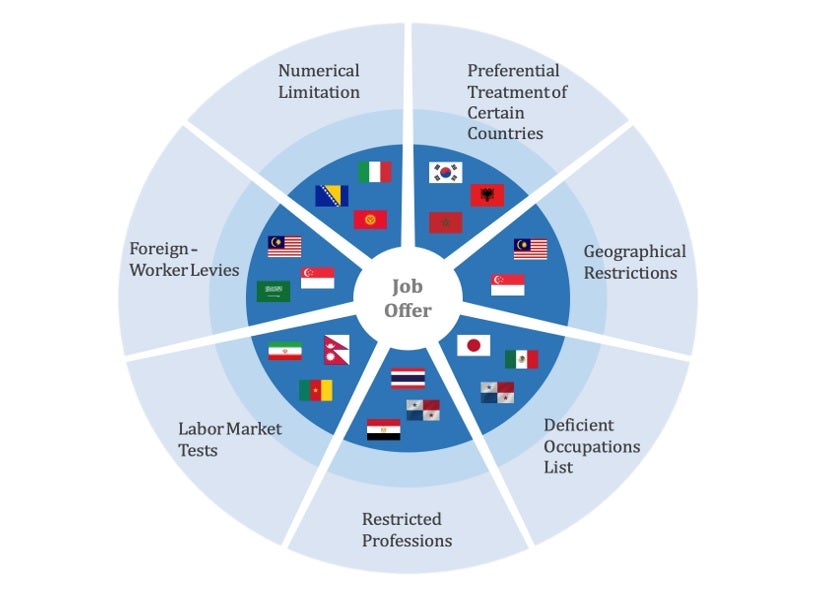In Observance of International Migrants Day (December 18)
Well-designed, coherent, and inclusive labor market policies are vital to ensure the welfare of migrants and their families, as well as their successful integration into the host communities. If unprotected by national legislation, migrants often end up in precarious and non-standard forms of employment that fall outside of social protection systems. KNOMAD’s Migration and the Law Project - From Immigration to Integration (henceforth the study) has developed 13 indicators on the extent to which national laws in host countries facilitate the ability of economic migrants and refugees to navigate the labor market. The study is a complement to the United Nations’ call for “well-managed migration policies” (under SDG target 10.7) as well as to the Global Compact for Safe, Orderly and Regular Migration (GCM) objectives to strengthen evidence-based and human rights-based policy-making.
The resulting Migration and the Law Database features country-specific data on domestic laws (as of 2016) affecting economic migrants in 152 countries and refugees in 134 countries. Overall, legal frameworks in Europe and Central Asia (ECA), Latin America and the Caribbean (LAC), and high-income OECD (HIO) countries are relatively more accommodating of refugees than of economic migrants. By contrast, the Middle East and North America (MENA), South Asia (SA), and East Asia and Pacific (EAP) tilt in favor of economic migrants (see figure 1). The Sub-Saharan African (SSA) region depicts the least disparity between the two groups, implying that the legal frameworks pertaining to economic opportunities for economic migrants and refugees are almost on par in the region.
Figure 1. East Asia and Pacific, South Asia, and Middle East and North Africa Countries Are More Accommodating of Economic Migrants than Refugees
Source: Migration and the Law Database
Note: To broadly compare host countries’ treatment of economic migrants and refugees, the regional indices for each were scored using a common set of countries for both groups. The scoring methodology is further described in the study.
The Migrant and the Law database further revealed a strong interlinkage between admission and integration policies. Migrants’ ability to navigate labor market of a host country depends on the type of work visa they hold; while the visa category itself is determined by a specific job offer or limited to workers with a particular set of skills. Beyond job offer, countries use various migration policy tools and selection methods including setting quotas on the size of the foreign workforce, restricting migrants to certain professions, creating labor market tests, singling out certain countries for preferential treatment, imposing geographical restrictions, creating lists of deficient occupations, and imposing foreign-worker levies (figure 2).
Figure 2. Economic Migrants Holding a Job Offer Need to Overcome Additional Labor Market Entry Barriers

Source: Migration and the Law database
With regards to the employment rights of refugees, the database alludes to three distinct patterns. In the first case, national laws treat refugees on par with citizens, lifting employment-related restrictions applicable to economic migrants. The second pattern finds laws bestowing refugees the most favorable treatment provided to foreigners, subjecting them to more lenient requirements short of treating them on par with citizens. Finally, there is a third pattern where national legislation fails to provide special protection for refugees, thereby compelling them to present themselves as migrant workers in order to enter the formal employment market.
The data presented in the study provide migration stakeholders with newfound context and nuance, as a part of the ongoing efforts to strengthen migration governance. Regular monitoring of national immigration legal frameworks is key to ensuring appropriate integration policy responses across the globe. The analysis alludes to several policy goals that host countries could consider to better facilitate economic and social integration of migrants:
- Align national legal frameworks with international human rights principles and international labor standards.
- Lower restrictions on migrants’ ability to access and navigate labor market, thereby fostering safe and regular labor migration channels and reducing countries’ reliance on informal work.
- Move towards delinking migrants’ ability to work and stay in the host country from a specific employer (sponsor), especially in the case of low-paid workers.
- Make comprehensive assessment of both short-term and long-term labor market needs through collaboration with private sector and adjust migration admission systems accordingly.
- Promote normalization of the family life of migrants by relaxing family reunification policies and facilitating dependents’ access to labor market.
- Extend social security protection measures to migrants, thereby reducing their vulnerability and mitigating the effect of large-scale shocks.
- Allow migrants to reside in the host country for a certain period of time after losing a job on which their residency was contingent.
Note: Part II of this blog addresses how national laws govern access of migrants and refugees to health, housing, and political opportunities.





Join the Conversation